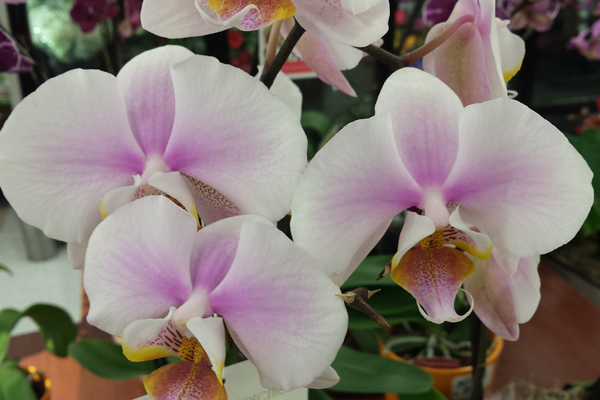UT Gardens February 2015 Plant of the Month: Supermarket Orchid

The phalaenopsis, or moth orchid, is a favorite gift orchid and is readily available in supermarkets and garden centers. It comes in a variety of colors and exotic patterns, and with care the long-lived blooms can be enjoyed for weeks. Photo by P. McDaniels, courtesy UTIA.
Did someone bless you with a beautiful orchid? Mass marketing has hit the orchid world!
Among the most popular orchids for gifting are cattleyas(pronounced “KAT-lee-uh”). Another favorite gift orchid is the genus phalaenopsis (pronounced “fail-en-NOP-sis”). This orchid is nicknamed the moth orchid because of the shape of its blooms. Both come in a variety of sizes and colors, are readily available in grocery stores and garden centers, and can look just as good in your home as the store.
In spite of the fact that my friends think I can grow anything with little regard for plant rules, I will confess that I managed to kill the first two orchids I was given years ago by simply not consulting the experts. Orchids are epiphytes or air plants that have developed specialized water-storage organs. They like to attach to moist tree bark in a tropical atmosphere. Thus, they have their own set of recommended growing practices. The American Orchid Society (aos.org) gives great advice on keeping your new friend healthy and blooming.
Both cattleyas and phalaenopsis appreciate a lot of air movement and a long day of filtered, bright light. They don’t appreciate direct sunlight but do thrive in temperatures between 60 and 85 degrees Fahrenheit. Living in an east-facing window usually makes them happiest.
Both orchids should be kept in free-draining growing media. The AOS recommends even moisture, although allowing the media to dry slightly can be beneficial. I recommend you water your orchid once a week, at most. Be sure the water can drain and does not stand in the pot. The pot it came in probably has no drainage, so your job is to not overwater. You can also create drainage holes.
Orchids should be watered in the morning. Because the water should run through the pot, place the plants in the sink. Tepid water is recommended. Also, do not use salt-softened or distilled water. Let the water run through the plant for a minute or so. Be sure to let the plant drain completely. If any water gets trapped in the leaves, use a paper towel to blot. This will help avoid crown rot. If you’ve read that you should just lay some ice cubes around the roots, I have found that generally works, also.
As for fertilizer, there are a number of mixtures and brands, but the AOS recommends that any fertilizer you use should not contain urea. Their website discusses recommended methods. If you want to try a home fertilizer brew, you might try your morning brew. I dump the dregs of my coffee pot into my orchids once a week, all year around. For an average pot with a 5-inch top measurement, about 1/4 cup of these leavings works best. Doing this will negate the job of occasional fertilizing, as the dregs give your new friend all the encouragement it needs to do its best. I use “high test” (caffeine) coffee leavings, but a friend is using decaf on hers. It will be interesting to see which formula produces the best results.
When orchids have completed their flowering cycle, it’s time to cut the flower stem to encourage a new bloom on a healthy plant. Again, the AOS has a number of tips about getting your orchid to re-bloom. For phalaenopsis, they recommend cutting the flower stem ½-inch above the first or second node. Be sure your pruners have been disinfected. The plant will most often grow another flower stem and re-bloom.
Repotting may be necessary every one to three years if the plant becomes root-bound or the media needs replenished. Don’t be tempted to substitute the loose medium that came with your orchid with your favorite soil mix. Orchids like orchid mixes that drain well, otherwise they may decline to the point of no return.
Now sit back and enjoy!
Carol Burdett is a Master Gardener with the Cumberland County Master Gardener Association. The Tennessee Master Gardener Program is a volunteer service program that trains and certifies volunteers in the science of horticulture and gardening. MG volunteers provide community service through county Extension offices. For more information, visit the website mastergardener.tennessee.edu or contact your local county UT Extension Office.
The University of Tennessee Gardens located in Knoxville, Crossville and Jackson are part of the UT Institute of Agriculture. Designated as the official botanical garden for the State of Tennessee, the gardens’ mission is to foster appreciation, education and stewardship of plants through garden displays, educational programs and research trials. The gardens are open during all seasons and free to the public except during designated special events. For more information see utgardens.tennessee.edu









